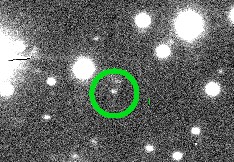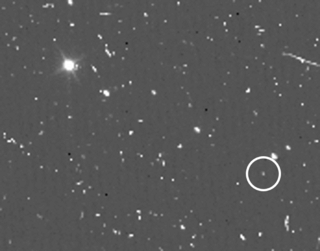Related Research Articles

The moons of Saturn are numerous and diverse, ranging from tiny moonlets only tens of meters across to the enormous Titan, which is larger than the planet Mercury. There are 146 moons with confirmed orbits, the most of any planet in the solar system. This number does not include the many thousands of moonlets embedded within Saturn's dense rings, nor hundreds of possible kilometer-sized distant moons that have been observed on single occasions. Seven Saturnian moons are large enough to have collapsed into a relaxed, ellipsoidal shape, though only one or two of those, Titan and possibly Rhea, are currently in hydrostatic equilibrium. Three moons are particularly notable. Titan is the second-largest moon in the Solar System, with a nitrogen-rich Earth-like atmosphere and a landscape featuring river networks and hydrocarbon lakes. Enceladus emits jets of ice from its south-polar region and is covered in a deep layer of snow. Iapetus has contrasting black and white hemispheres as well as an extensive ridge of equatorial mountains among the tallest in the solar system.

Skathi, also named Saturn XXVII and originally spelled Skadi, is a natural satellite of the planet Saturn. Skathi is one of Saturn's irregular moons, in its Norse group of satellites. It was discovered on September 23, 2000, by a team of astronomers led by Brett Gladman. The team announced their discovery on December 7, 2000, along with seven other satellites of Saturn, namely; Tarvos, Ijiraq, Thrymr, Siarnaq, Mundilfari, Erriapus, and Suttungr. The moon was named after Skaði, a figure in Norse mythology, as part of an effort to diversify the largely Greek and Roman names of astronomical objects.

Narvi or Saturn XXXI is a natural satellite of Saturn. It was discovered by a team of astronomers led by Scott S. Sheppard in 2003, and given the temporary designation S/2003 S 1.

Fornjot or Saturn XLII is the outermost named moon of Saturn. Its discovery was announced by Scott S. Sheppard, David C. Jewitt, Jan Kleyna, and Brian G. Marsden on 4 May 2005 from observations taken between 12 December 2004, and 11 March 2005. It had the largest semi-major axis among all the known moons of Saturn
Farbauti or Saturn XL is a natural satellite of Saturn. Its discovery was announced by Scott S. Sheppard, David C. Jewitt, Jan Kleyna, and Brian G. Marsden on May 4, 2005, from observations taken between December 12, 2004, and March 9, 2005.

Bestla or Saturn XXXIX is a retrograde irregular moon of Saturn. Its discovery was announced by Scott S. Sheppard, David C. Jewitt, Jan Kleyna, and Brian G. Marsden on 4 May 2005, from observations taken between 13 December 2004 and 5 March 2005.

The Norse group is a large group of retrograde irregular satellites of Saturn. Their semi-major axes range between 12 and 27 Gm, their inclinations between 136° and 178° and their eccentricities between 0.06 and 0.63. Unlike the Inuit and Gallic groups, the orbital parameters are widely dispersed and the group is likely to be composed from a number of subgroups with more homogeneous orbital and physical parameters. The International Astronomical Union (IAU) reserves names taken from Norse mythology for these moons. The exception is Phoebe, the largest, which was discovered long before the others.

Hyrrokkin or Saturn XLIV is a natural satellite of Saturn. Its discovery was announced by Scott S. Sheppard, David C. Jewitt, Jan Kleyna, and Brian G. Marsden on June 26, 2006, from observations taken between December 12, 2004, and April 30, 2006.

Kari or Saturn XLV is a natural satellite of Saturn. Its discovery was announced by Scott S. Sheppard, David C. Jewitt, Jan Kleyna, and Brian G. Marsden on 26 June 2006 from observations taken between January and April 2006.
Surtur or Saturn XLVIII is a natural satellite of Saturn. Its discovery was announced by Scott S. Sheppard, David C. Jewitt, Jan Kleyna, and Brian G. Marsden on June 26, 2006 from observations taken between January and April 2006. It was named after Surt, a leader of the fire giants of Norse mythology.

Skoll or Saturn XLVII is a retrograde irregular satellite of Saturn. Its discovery was announced by Scott S. Sheppard, David C. Jewitt and Jan Kleyna on 26 June 2006 from observations taken between 5 January and 30 April 2006.
Gridr, originally known as S/2004 S 20, is a natural satellite of Saturn. Its discovery was announced by Scott S. Sheppard, David C. Jewitt, and Jan Kleyna on October 7, 2019 from observations taken between December 12, 2004 and March 22, 2007. It was given its permanent designation in June 2021. On 24 August 2022, it was officially named after Gríðr, a jötunn in Norse mythology. She is the mother of Víðarr the silent and the consort of Odin. She warned Thor about the treachery of Geirröðr and equipped him with her belt of strength, her iron glove, and her staff Gríðarvöl (Gríðr's-staff).
Skrymir, provisionally known as S/2004 S 23, is a natural satellite of Saturn. Its discovery was announced by Scott S. Sheppard, David C. Jewitt, and Jan Kleyna on October 7, 2019 from observations taken between December 12, 2004 and March 22, 2007. It was given its permanent designation in August 2021. On 24 August 2022, it was officially named after Útgarða-Loki. He is a jötunn from Norse mythology and master of illusions.
Gerd, provisionally known as S/2004 S 25, is a natural satellite of Saturn. Its discovery was announced by Scott S. Sheppard, David C. Jewitt, and Jan Kleyna on October 7, 2019 from observations taken between December 12, 2004 and March 22, 2007. It was given its permanent designation in August 2021. On 24 August 2022, it was officially named after Gerðr, a jötunn from Norse mythology. She is married to Freyr and the personification of fertile soil.
Eggther, provisionally known as S/2004 S 27, is a natural satellite of Saturn. Its discovery was announced by Scott S. Sheppard, David C. Jewitt, and Jan Kleyna on October 7, 2019 from observations taken between December 12, 2004 and March 21, 2007. It was given its permanent designation in August 2021. On 24 August 2022, it was officially named after Eggþér, a jötunn from Norse mythology. He is the herder of the female jötunn who lives in Járnviðr (Ironwood) and raises monstrous wolves. In the poem Völuspá, Eggþér is described as sitting on a mound and joyfully striking his harp while the red rooster Fjalarr begins to crow to herald the onset of Ragnarök.
Beli, provisionally known as S/2004 S 30, is a natural satellite of Saturn. Its discovery was announced by Scott S. Sheppard, David C. Jewitt, and Jan Kleyna on October 7, 2019, from observations taken between December 12, 2004, and March 21, 2007. It was given its permanent designation in August 2021. On 24 August 2022, it was named after Beli, a jötunn from Norse mythology. He is killed by Freyr with the antler of a hart (stag). According to John Lindow, the myth of Beli is partially lost. Some scholars suggest that he may be the brother of Freyr's wife Gerðr, although this is uncertain.
Gunnlod, provisionally known as S/2004 S 32, is a natural satellite of Saturn. Its discovery was announced by Scott S. Sheppard, David C. Jewitt, and Jan Kleyna on October 8, 2019 from observations taken between December 12, 2004 and January 19, 2007. It was given its permanent designation in August 2021. On 24 August 2022, it was officially named after Gunnlǫð, a jötunn from Norse mythology. She is the daughter of Suttungr and guarded the mead of poetry for him. But Odin in the form of a snake gained access to the chamber in Hnitbjorg where the mead was kept, seduced Gunnlǫð, and slept with her for three nights. In return Gunnlǫð allowed Odin three drinks of the mead, and he then immediately flew out of the cavern in the form of an eagle.
Thiazzi, provisionally known as S/2004 S 33, is a natural satellite of Saturn. Its discovery was announced by Scott S. Sheppard, David C. Jewitt, and Jan Kleyna on October 8, 2019 from observations taken between December 12, 2004 and March 22, 2007. It was given its permanent designation in August 2021. On 24 August 2022, it was officially named after Þjazi, a jötunn from Norse mythology. He is a son of Alvaldi and kidnapped the goddess Iðunn, who guarded the apples of the gods.
Alvaldi, provisionally known as S/2004 S 35, is a natural satellite of Saturn. Its discovery was announced by Scott S. Sheppard, David C. Jewitt, and Jan Kleyna on October 8, 2019 from observations taken between December 12, 2004 and February 25, 2006. It was given its permanent designation in August 2021. On 24 August 2022, it was officially named after Alvaldi, a jötunn from Norse mythology. He was very rich in gold, and when he died his sons divided his inheritance by taking a mouthful each.
Geirrod, provisionally known as S/2004 S 38, is a natural satellite of Saturn. Its discovery was announced by Scott S. Sheppard, David C. Jewitt, and Jan Kleyna on October 8, 2019 from observations taken between December 12, 2004 and March 22, 2007. It was given its permanent designation in August 2021. On 24 August 2022, it was officially named after Geirröðr, a jötunn from Norse mythology. He is an enemy of Thor and is killed by him.
References
- ↑ Discovery Circumstances from JPL
- 1 2 S.S. Sheppard (2019), Moons of Saturn, Carnegie Science, on line
- 1 2 "MPEC 2019-T128 : S/2004 S 22". minorplanetcenter.net. Retrieved 7 October 2019.
- ↑ "M.P.C. 133821" (PDF). Minor Planet Center. International Astronomical Union. 10 August 2021. Retrieved 21 August 2021.
- ↑ "Names Approved for 10 Small Satellites of Saturn". usgs.gov. USGS. 24 August 2022. Retrieved 30 August 2022.
- ↑ Lindow, John (2002). Norse Mythology: A Guide to Gods, Heroes, Rituals, and Beliefs. Oxford University Press. p. 59. ISBN 978-0-19-983969-8.